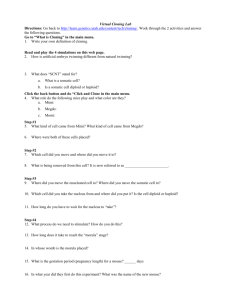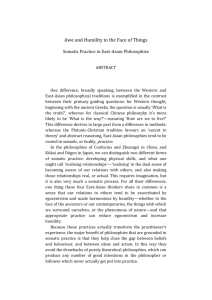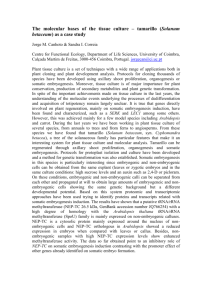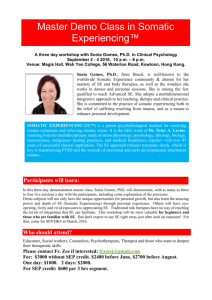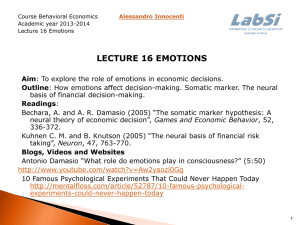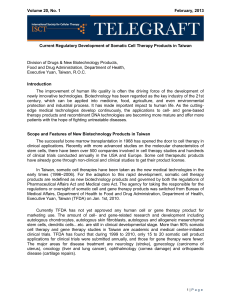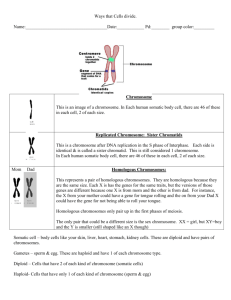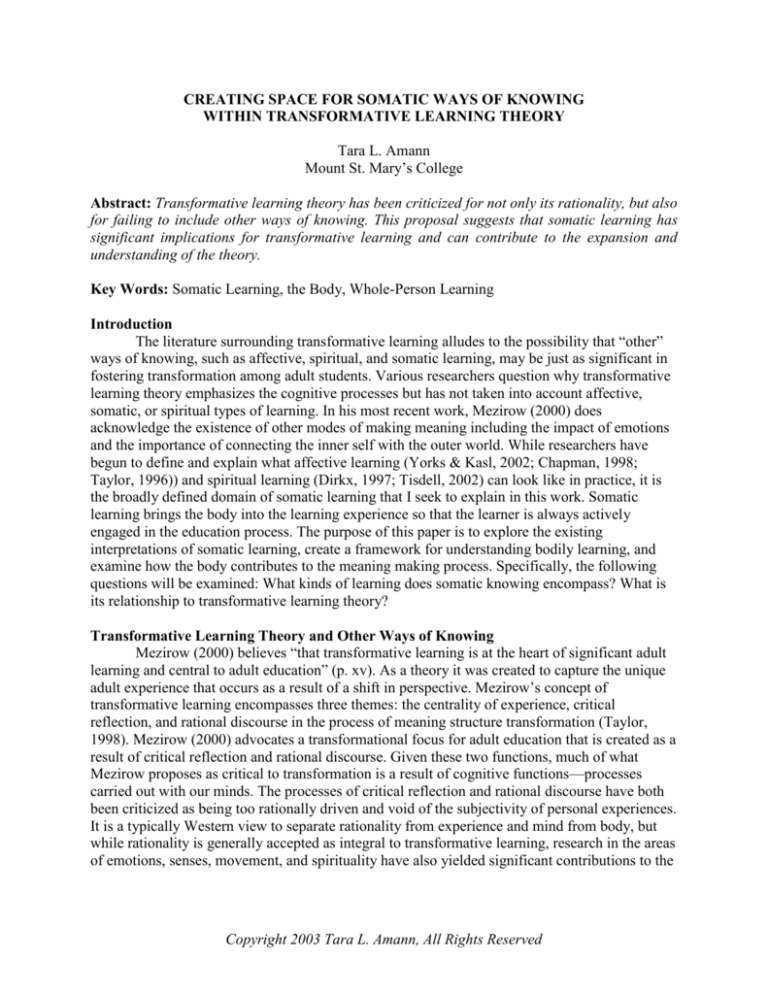
CREATING SPACE FOR SOMATIC WAYS OF KNOWING
WITHIN TRANSFORMATIVE LEARNING THEORY
Tara L. Amann
Mount St. Mary’s College
Abstract: Transformative learning theory has been criticized for not only its rationality, but also
for failing to include other ways of knowing. This proposal suggests that somatic learning has
significant implications for transformative learning and can contribute to the expansion and
understanding of the theory.
Key Words: Somatic Learning, the Body, Whole-Person Learning
Introduction
The literature surrounding transformative learning alludes to the possibility that “other”
ways of knowing, such as affective, spiritual, and somatic learning, may be just as significant in
fostering transformation among adult students. Various researchers question why transformative
learning theory emphasizes the cognitive processes but has not taken into account affective,
somatic, or spiritual types of learning. In his most recent work, Mezirow (2000) does
acknowledge the existence of other modes of making meaning including the impact of emotions
and the importance of connecting the inner self with the outer world. While researchers have
begun to define and explain what affective learning (Yorks & Kasl, 2002; Chapman, 1998;
Taylor, 1996)) and spiritual learning (Dirkx, 1997; Tisdell, 2002) can look like in practice, it is
the broadly defined domain of somatic learning that I seek to explain in this work. Somatic
learning brings the body into the learning experience so that the learner is always actively
engaged in the education process. The purpose of this paper is to explore the existing
interpretations of somatic learning, create a framework for understanding bodily learning, and
examine how the body contributes to the meaning making process. Specifically, the following
questions will be examined: What kinds of learning does somatic knowing encompass? What is
its relationship to transformative learning theory?
Transformative Learning Theory and Other Ways of Knowing
Mezirow (2000) believes “that transformative learning is at the heart of significant adult
learning and central to adult education” (p. xv). As a theory it was created to capture the unique
adult experience that occurs as a result of a shift in perspective. Mezirow’s concept of
transformative learning encompasses three themes: the centrality of experience, critical
reflection, and rational discourse in the process of meaning structure transformation (Taylor,
1998). Mezirow (2000) advocates a transformational focus for adult education that is created as a
result of critical reflection and rational discourse. Given these two functions, much of what
Mezirow proposes as critical to transformation is a result of cognitive functions—processes
carried out with our minds. The processes of critical reflection and rational discourse have both
been criticized as being too rationally driven and void of the subjectivity of personal experiences.
It is a typically Western view to separate rationality from experience and mind from body, but
while rationality is generally accepted as integral to transformative learning, research in the areas
of emotions, senses, movement, and spirituality have also yielded significant contributions to the
Copyright 2003 Tara L. Amann, All Rights Reserved
process of transformation (Bach, Kennedy, and Michelson, 1999; Hannaford, 1995; Tisdell,
2003; Taylor, 1996, Brooks & Clark, 2001, Barlas, 2001).
Mezirow’s approach to transformative learning is also accused of deemphasizing the
importance of context, specifically personal and sociocultural factors. In Taylor’s (1998) review
of the literature several studies were cited that highlighted the importance of prior experience and
historical and geographic influences, concluding that learning cannot be confined to the
processes of the mind, but are “distributed—stretched over, not divided among—mind, body,
activity, and cultural organized settings” (Lave, 1988, p.1). The mind therefore, does not act in
exclusion during learning events. Our body and how it experiences emotion, sense, or
movement, for example, simultaneously engages in taking in and making sense of information.
The cognitive and somatic functions work in conjunction with our cultural background to make
meaning from our experience. Schlattner (1994) rationalizes that “each learner is constituted
with a body which itself participates in all learning experiences and reacts in learned ways to
situations,” (p. 325) which implies that the body has an integral role in the building of meaning
perspective and schemes. Taylor (1998) also examines “other ways of knowing” as part of his
literature review and cites a study by The Group for Collaborative Inquiry (1994) that
acknowledged the significance of whole person learning, which includes use of “cognitive,
affective, somatic, intuitive, and spiritual domains” (p. 171). Scientific research is increasingly
clarifying the body’s role in learning and debunking the myth that thinking and learning are
exclusive to our heads (Hannaford, 1995). Hannaford (1995) argues that it is the “body’s senses
that feed the brain environmental information with which to form an understanding of the world
and from which to draw when creating new possibilities (p.11).”
In order to expand the understanding of alternative ways to construct meaning from adult
experiences, the field of somatic knowing/learning merits further investigation to determine how
it may contribute to further shaping the theory of transformational learning. However, the
primary way society instructs us to know or accepts our knowing rests in the cognitive domain,
and as a result, little information exists regarding learning from our somatic knowledge (Clark,
2002; Dirkx, 1997; Beaudoin, 1999). Information gained through emotion or movement
capitulates to information that results from our intellect or ability to reason. In essence, modern
society requires “the knower and the known be separate and distinct” (Clark, 2001, ¶ 3).
Schlattner (1994) discusses a post-structuralist epistemology for embracing a more holistic
approach to learning where the person contributes to his/her knowledge acquisition. While she
advocates the melding of the body into the transformative learning process, Schlattner cautions
that the body can only remain a separate component conceptually—it is always part of the
greater whole (1994). Given that current thinking on the mind/body debate generally agrees that
Descartes did indeed make a grave error so many years ago, the time has come to explore how
the body, through its movements, senses, emotions, and spirit contributes to transformative
learning.
Defining Somatic Learning
The existing literature regarding somatic learning at first glance appears minimal, but a
deeper investigation reveals that bodily learning takes on many forms in various disciplines.
Matthews (1998) defines somatic knowing as “an experiential knowing that involves sense,
precept, and mind/body action and reaction—a knowing, feeling, and acting that includes more
of the broad range of human experience” (¶ 4). At its core, he describes somatic knowing as an
“embodied experience of being and doing (¶ 4). To embody something is to give it a body.
2
Therefore, embodied learning literally means giving a body to learning. Somatic learning often
occurs in experiential learning, where the learner becomes an active participant in the knowledge
acquisition process through activities like role plays and discussion. Clark (2001) generalized
somatic learning even more, describing it as “how we learn from our bodily experience” (¶ 3).
She gives the example of how often stress manifests itself in our body before our mind
recognizes the situation as an example to how we discount the body’s message until our minds
can define it. While these two definitions sound similar, it is necessary to explain what somatic
learning looks like in action. Clark (2001) provides examples of somatic learning ranging from
the artistic to the emotional to the physical. Others have included the body in the learning
process using movement and art (Crawford, 1998) tacit learning (Durrance,1998) and dance
(Fortin, 1998). Crowdes (2000) also used experiential techniques with somatic and emotional
learning with sociology students studying power relations. She explains somatic learning in
terms of a “conscious embodiment” that goes beyond simply connecting the affective and
cognitive domains in experiential learning. Further, “it implies an integrity of mind, body, and
action accompanied by some awareness in the broader social context” (p. 27). Conscious
embodiment includes but is not limited to body posture, style, emotions, and simple body actions
(Crowdes, 2000).
Chapman recognizes the recent push to acknowledge affective and somatic knowledge,
but makes the case that it is unnecessary to re-invite the body to the classroom, as it has always
been present (1998). For her, recognition of bodies in the classroom opens the door for a vast
array of psychological and sociological issues, including gender, power, race, and sexual
orientation. Like Matthews (1998), Chapman (1998) views somatic learning from an embodied
perspective. She references Schatzki’s (1996) model of corporeality, the embodiment of
socioculturation, which distinguishes between the physical body, bodily activity, the lived body,
and the surface of the body. The model purports that the body is socially sculpted by our
practices in both political and social realms. For example, eating and drinking habits reflect on
the physical health of our body, and our gender, character and mental health reflect onto our
bodily activity. The lived body is the actual experience of giving a body to the self—the act of
emodiment. The surface of the body is where we often place or wear social or cultural symbols
such as tattoos, jewelry, piercings, or clothing as a symbol of our beliefs, values, or attitudes.
From Schatzki’s model Chapman proposes an understanding of how educational discourse and
institutions contribute to represent bodies and ultimately, identities (1998).
The body as a medium for understanding society and culture is also discussed by
Brockman (2001) who uses a multicultural and postmodern lens for viewing somatic knowing,
which he describes as knowledge known by the body through physical sensation. He believes
that somatic knowing offers a fundamental knowledge source that can aid educators and
philosophers in sorting “the cultural goods from the cultural evils” (¶ 19). Like Matthews (1998),
Brockman (2001) views the exclusion of somatic knowing in favor of cultural-linguistic
dimensions as extremely problematic. A cultural-linguistic approach transmits knowledge
through a lens emphasizing the customs, beliefs, and social norms combined with speech
patterns of a particular race, religious or social group. By assuming knowledge to be historical,
cultural, and linguistic in nature it implies that groups of different cultures are unable to learn
from one another. In other words, if knowledge is constructed culturally and linguistically, then
it may not be transferable to other cultural and linguistic systems. Brockman (2001)
differentiates somatic knowledge as being received from within the individual and cultural
knowledge as being received from without the individual. Consider someone who has just been
3
diagnosed with a disease. The individual can research the condition and talk to others with the
same disease, which is a way of acquiring cultural-linguistic knowledge. However, until the
individual begins to experience the symptoms of their disease, the knowledge they have comes
from outside the body. Going through the disease and experiencing it within the body becomes a
somatic experience. The knowledge gained from pain, discomfort, or fatigue then becomes more
tangible and concrete than the knowledge received from others. Because somatic knowledge is
experienced directly, it can offer a dimension of learning that is common to all cultural contexts.
Fundamentally, each definition positions somatic learning or knowing within or through
the body rather than knowledge about or without the body (Matthews, 1998; Chapman, 1998;
Brockman, 2001; Clark, 2001; Sellers-Young, 1998). Chapman (1998), Brockman (2001), and
Crowdes (2000) all recognize the body’s inclusion in the learning environment as having
implications for how we make sense of social and cultural norms and issues such as power and
gender. Matthews (1998), Sellers-Young (1998), Michelson (1998), and Crowdes (2000) all
recognize somatic learning as experiential and involving the body’s action and reaction. Each
uses similar terminology to define experiential learning such as knowledge that is gained through
the senses or perception as well as the reactive knowing, feeling or acting that results from tacit
involvement. Experiential exercises, such as debate, group collaboration, and action-oriented
activities, create learning through our experiences, and a major contributor to experience occurs
from our environment, which includes all of our senses and our bodies via nerve receptors on
each muscle and organ (Hannaford, 1995). The body is designed to gather information both
externally through our sensory organs or internally where each movement instantaneously carries
a chaotic selection of impulses quickly to the brain so it knows precisely where the body is in
space. Such critical sensations provide us with ideas of the self and the world as well as creating
a basis for knowledge. We learn first through our senses, and through exploration of the world,
initial sensory patterns are mapped out on elaborate nerve networks. The sensory patterns form
the center of our personal information system and become more complex and rich with each new
experience. Each sensory pattern provides a context for all learning, thought, and creativity
(Hannaford, 1995). Thus, experiential learning provides authentic learning opportunities that
engage the whole learner.
A limitation of the existing definitions offered in the literature suggest that the term
“somatic” is being used indiscriminately whether the author means to explain, for example,
affective or kinesthetic learning. The definitions offered in the literature for somatic ways of
understanding often admit they overlap other ways of learning, such as spiritual learning, but
explaining this overlap in cognitive terms is difficult. Somatic learning is felt by the body, and
defining such knowing in rationale terms has limited not only the understanding of somatic
education but also its development. While the range of learning that is classified within somatic
learning is broad and interpreted differently, it is the body itself that continuously emerges as a
multi-faceted force for making meaning of our experience. In response to this ambiguity, a
framework developed that encompasses four domains, with each being somatic in nature. The
framework resulted from a review of the literature that revealed “somatic” learning or knowing
was often represented under other terminology. Since somatic simply means relating to or
affecting the body, somatic learning, as illustrated in the literature reviewed, can be categorized
into four main areas: kinesthetic, sensory, affective, and spiritual.
4
Kinesthetic Learning
Learning that occurs as a result of the concerted movements of muscles, tendons, and
joints is labeled kinesthetic. Drawing on his experience as a high school cross-country and track
runner, Matthews describes his involvement in athletics as an embodied experience that allowed
him to endure the disembodied high school curriculum (1998). The somatic engagement
expressed by Matthews is echoed in a reference to long distance running by Csikzentmihalyi
(1990) who describes bodily learning as, “the simple act of moving the body across space
becomes a source of complex feedback that provides optimal experience and adds strength to the
self” (p. 95). Matthews (1998) references Csikzentmihalyi’s (1990) concept of “flow,” the
occurrence of being so actively involved in something that we are oblivious to distraction, time
becomes irrelevant, and the mind and body work as one. Advocating that all fields and levels of
education can benefit from an embodied approach to education, Matthews (1998) warns that
continuing to follow a bodily detached attitude toward learning will reinforce obsession with
grades and paper and pencil learning and alienate scores of students who learn in other ways.
Beaudoin (1999) conducted a study of six adults who integrated somatic education into
their everyday lives using body-centered approaches. She describes somatic education as
approaches that aid individuals in developing increased awareness of their bodies in movement.
Beaudoin’s research examined the areas of daily life that somatic education participants applied
their learning to improve their efficiency and quality of life and the level of integration they
achieved. Participants had an average of six years of experience using body-centered approaches
such as the Eutonia method, Alexander and Feldenkrais techniques, yoga, and Somarythm. Data
collection occurred through interviews asking participants to describe the life circumstance
where they used somatic learning with particular attention paid to the transference of this
learning to daily living. Over a six-month period, each participant was interviewed on average
six times. The interviews yielded 70 integration stories. Beaudoin found that participants chose
to use somatic techniques mainly when they were suffering emotional discomfort such as fear,
anger, or distress. She determined six somatic learning elements were most helpful to the
participants: a) doing some movement, b) modifying body posture, c) coming back to body
sensations, d) being attentive to what was happening, e) letting themselves go along with what
was happening or what they were feeling, and f) developing a quality of “presence” (1999).
These somatic education techniques tie movement to body awareness creating a kinesthetic
version of somatic learning.
Kinesthetic learning is also recognized by Gardner (1983) in his theory of multiple
intelligences. The theory proposes that human beings have all of the intelligences, but each
person has a unique combination, or profile. We possess the capability to improve our
intelligences, but some people have natural tendencies in certain areas. Gardner (1983)
recognizes seven areas of intelligence, including bodily kinesthetic intelligence, which is the
ability to control one's body movements and to handle objects skillfully. Someone possessing
bodily kinesthetic intelligence expresses themselves through movement and also prefers this
method for learning. Bodily kinesthetic learners can be athletes, artists, dancers, or inventors.
Recognizing kinesthetic learning as a facet of somatic learning opens up possibilities not only for
how information is presented but also for learning by individuals whose strengths lie in bodily
kinesthetic intelligence.
Fundamentally, kinesthetic learning involves movement. From the use of fine and/or
gross motor skills, our bodies spring into action. The body produces movement and action that
often yields lessons about discipline, diligence, dealing with stress, or solving problems.
5
Kinesthetic learners need to be actively engaged in their learning by involving hands-on
manipulation, physical involvement, and role plays.
Sensory Learning
Utilizing the five senses to construct knowledge or make meaning of our learning is
considered sensory learning. Our senses of seeing, hearing, tasting, touching, and smelling each
require a distinct function of our bodies, and as information is accumulated through each sense,
we relate that information to our experience and extrapolate meanings significant to our lives.
Bach, Kennedy, and Michelson (1999) explore sensory knowing through autobiographical
narratives of sensory perception as a way of relating the senses of hearing, visual awareness,
speech/verbal expression and the sense of smell to pedagogy. Each author shares personal stories
from a historical context and relates learning experiences to each of our senses. As an example,
one of the authors relates a story about how her family’s mealtimes during childhood were spent
in silence as dictated by her father. She learned that expression of any sort at the dinner table
equated into punishment; even laughter was not tolerated. She came to feel that being silent was
necessary for survival and that her “body was devalued, and became a repository for all that was
deemed undesirable” (¶ 12). Bach, Kennedy, and Michelson (1999) conclude that “It is through
stories of understanding our bodies and our senses, through all their migrations and
peregrinations, their processes and their connections, that we wish to make meaning in our lives”
(¶ 46). They advocate opening curriculum to incorporate sentience, a consciousness of
perception and thought that occurs through our senses. Because our eyes, ears, mouth, nose, and
ability to touch are all part of our bodies, sensory learning is inherently somatic.
Affective Learning
The acquisition of knowledge as a result of paying attention to and honoring our feelings
and emotions is called affective learning. Many times in life we find ourselves at a decision point
and although our head examines the rational choices we can make, our gut or an internal feelings
instruct us otherwise.
Emotional Intelligence as also emerged in mainstream literature as a way of measuring an
individual’s control over emotional responses. Goleman’s (1995) work in particular has made an
impact on the management field as business programs realize the importance of the “soft skills”
in the workplace. Emotional intelligence is fundamentally about self-awareness. Being aware of
our emotions and being able to identify them, gives us an opportunity to reflect on the impulses
certain emotions cause. We then make choices about how to react—we can choose our first
impulse, or we can decide on a mutually beneficial response for all parties involved. Recognizing
the impact of emotions on our personal and professional lives has further legitimized the
affective realm as a domain of learning.
Yorks & Kasl (2002) wholeheartedly advocate a push toward a more holistic view of
learning but acknowledge that many educators are unsure of how to handle emotions and
feelings in the context of the classroom. They caution that the pragmatist view of experiences
“casts affective knowing as an object for reflection, [and] so permeates adult education discourse
that it has narrowed our theoretical vision and truncated our practice” (Yorks & Kasl, 2002, ¶
25). Yorks & Kasl (2002) therefore recommend a theoretical roadmap to guide educators and
specifically the use of four interconnected ways of knowing—experiential, presentational,
prepositional, and practical to more fully embrace the learner as a whole person.
6
Taylor (1996) examined the role of emotions within transformative learning theory from
a neurobiological perspective and found that while feelings are recognized as part of
transformative learning, the interactive relationship between emotion and rationality is still
unacknowledged. Using affective learning or fostering emotional intelligence requires some of
the same interactive, experiential techniques as are found in kinesthetic and sensory learning.
Collaborative learning that involves discussion and role play can be valuable for understanding
differing perspectives, resolving conflict, and improving communication. Again, the use of the
body emerges as integral to such activities.
Spiritual Learning
Including spiritual learning within this model of somatic learning makes sense primarily
because spirituality is basically about making meaning of our lives. One of Tisdell’s (2003)
definitions states that spirituality is how people construct knowledge, and this process is often
carried out in symbolic and unconscious ways such as creating art through music, art, imagery,
symbols, and rituals. Symbols then can be a concept, a person, a physical object that has a
particular meaning, or a movement or gesture (Tisdell, 2003). Much of the spirituality literature
makes direct links between our spiritual learning and learning through our feelings, senses, and
movements. Spiritual writer Gary Zukov (2000) suggests a multisensory type of constructing
knowledge that not only uses the five senses but other modes such as intuition.
Wuthnow (2001) explores the role of the artist and spirituality citing many stories of how
artists interpret and define their own spiritual journeys and discoveries. A painter, Nancy Chinn
described a particular spiritual experience as this: “the phrase ‘God is a Spirit’ flowed into me
and I understood in a kinesthetic way what that meant” (p. 23). She believes spirituality should
be sensual; “relating to God should be so emotionally fulfilling that it generates bodily
movement” (p. 24). Wuthnow also interview a dancer, Ann Biddle who similarly found chanting
as “kinesthetic, physiological” (p. 109). She “could feel something happening” (p. 109,
emphasis mine). For Biddle, “the kinesthetic effect of chanting is especially meaningful because
it resembles the bodily transformation that occurs from dancing” (p. 110). Often Biddle will
choreograph a piece that came to her while chanting, which she describes as a spiritual place. At
their core, these two women found their spiritual experiences to be intertwined and dependent on
a simultaneous bodily experience. For them, the overlap of spiritual and somatic learning is quite
clear.
Other examples of the somatic and spiritual domains overlapping occur in Tisdell’s
(2003) work. A Chinese American woman named Janine commented on her experience giving
birth as a somatic experience. “The most cosmic spiritual transformative events of my life are
strongly related to the body. One was giving birth to my daughter” (p. 76). These are only a few
of the many stories that combine spiritual learning and experience with other domains of somatic
learning such as affective, sensory, and kinesthetic. The intent here is to simply demonstrate that
by combining the cognitive domain with the many forms of somatic learning, “learning itself
becomes more holisitic, thereby increasing the chance for learning to be transformative” (Tisdell,
2003, p. 42).
Developing a Model
The rationale for this model builds upon each of the previously identified definitions in
that meaning making is created by the body through movement, each of the five senses,
emotions, and/or our spirituality. The model offers a visual explanation of how somatic learning
7
often acts as an umbrella for many types of bodily learning and that each of the four domains
also often intersects with one another.
Somatic Learning Model
Kinesthetic Learning
[movement creates neaning]
Sensory Learning
[Making meaning through
the senses]
Somatic Learning
Affective Learning
[meaning results from
emotions or feelings]
Spiritual Learning
[interconnectedness, selfawareness]
Consider the kinesthetic knowledge gained by the long distance runner who learns
lessons about discipline and diligence through her sport. A new mother experiences affective
learning through a tidal wave of emotions and feelings while learning to caring for her infant. As
a young child, we learn by touching a hot stove or tasting a bitter lemon that those experiences
are unpleasant; we absorbed this new knowledge through our senses. The artist who creates
beautiful music or art utilizes both movement and sense in a symbolic process of making
spiritual meaning. From a spiritual perspective, we begin to see how the domains overlap—the
artist uses motor skills and sensory organs to create her music or art, and the process or end
result often creates a spiritual experience. Consider the practice of yoga as an example of how
the body draws on each of the four ways of bodily learning. The muscles move in conjunction
with purposeful breathing creating a flow state that often leaves the mind open to emotions that
we may not acknowledge in other settings (Csikszentmihalyi, 1990). The ears absorb music and
8
the eyes take in candlelight that sets the tone for the practice. This interconnection of movement,
emotion, and sense often result in a feeling of connectedness, which touches on the spiritual
realm. The result is a rich somatic experience—an overlapping of the multiple ways our body
contributes to learning.
Implications of Somatic Learning for Transformative Learning
After reviewing the somatic learning literature, the question remains of exactly how
somatic ways of knowing impact transformative learning. According to Matthews (1998), “A
somatically involved education will more likely lead to student transformation, which should be
the goal of all education.” What Matthews means is that learning should be experiential—the
learner who is viewed as possessing both a mind and a body and given permission to use the two
in tandem, will more likely find the educational experience to be transformational. Given the
multiple ways to include somatic learning in the learning environment, it is important to explore
examples of how such integration has fostered transformative learning.
Integrating the Domains
The concept of integration of multiple modes of somatic learning identified in the model
above offers implications for transformative learning. Brooks and Clark (2001) utilize narratives
to encompass the cognitive, affective, spiritual, and somatic dimensions. They make the case that
in order for a story to be accepted by our society, it must somehow make a cognitive link by
having a “point” to the story. Stories that are particularly compelling often appeal to affect in that
they can possibly cause people to feel differently or experience a change in opinion or a call to
action. The narratives embrace spiritual and somatic learning when the story touches us on a
visceral level where we are left touched or moved in some way from the information we have
read. Brooks and Chapman see narrative as a way to understand and theorize transformative
learning because it “a) moves from past to future, (b) spans the psychological, social, cultural,
and historical dimensions in content and form, and (c) includes cognitive, affective, spiritual, and
somatic dimensions” (2001).
The integration of multiple learning dimensions is often labeled “whole-person learning.”
Whole-person learning values the cognitive, affective, somatic, and spiritual realms of the
individual. In a qualitative study of 20 adults participating in a cohort-based transformative
learning and change doctoral program, Barlas (2001) discovered implications for whole-person
learning and transformative learning. First, the valuing of emotions by the instructor and the
cohort can be critical for reflective learning and for creating transformative learning and action.
Secondly, by creating a space for learning “into which the diversity of the whole self was invited
provided the learners with the experience of inclusivity” (Barlas, 2001, ¶ 18). The students were
better able to actively listen and view different perspectives in an atmosphere of trust and
acceptance that were fostered by the instructor. Barlas (2001) therefore establishes a link
between the importance of inclusiveness and whole-person learning to fostering transformative
learning.
Instructors who strive to create transformative learning experiences for their students can
take many things from the somatic learning model offered here. Somatic learning offers to
transformative learning an opportunity to break out of the thinking that the mind offers the only
road to transformational experience. By incorporating learning experiences that engage the
whole person and often several modes of learning, a more complete, sometimes transformational,
learning experience will occur. Kinesthetic learning offers the opportunity for students to move
9
by engaging in role plays or dramatizations of situations or cases. Participating in building or
creating activities that require use of fine and/or gross motor skills also provide kinesthetic
experience. Sensory learning can be incorporated using music or artwork that is interpreted
visually and aurally in relation to the subject matter being taught. Storytelling has also been
proven useful to capitalize on the sensory experiences of our pasts. We can bring emotions and
feelings to the forefront of our classrooms by illustrating the power and significance of emotional
awareness. The ability to recognize emotions in a variety of situations is a valuable development
tool for adults in any field. From a spiritual perspective, we can give students opportunities for
expression through movement, art, music, or symbol to construct meaning, connectedness, and
awareness. Each of these options centralizes the body so that it is integral to the learning
experience. Combined with opportunities for reflection, somatic learning contributes a new
perspective to the scope of transformative learning.
Conclusion
Most of us use somatic learning as part of our everyday lives in the ways that we take in
information and make sense of the world around us. We are capable of learning from each of the
four domains discussed in this paper, but some people may be more developed in one domain
over others. If we were raised to limit our emotional expression or to discount our feelings or
intuition when making decisions or learning from life experience, we may not recognize or rely
on affective learning. Similarly, anyone who has not developed an awareness of his or her
spiritual self or experienced spirituality in a recognizable way may not consider this area of
learning when taking in new information. If we recognize our body as a significant part of our
ability to acquire knowledge rather than as a means of transporting our brains from place to
place, the somatic richness of our learning experiences becomes distinctly visible.
References
Bach, H., Kennedy, M. & Michelson, J.R. (1999). Bodies at work: Sensory knowing.
Teaching Education, 10 (2), 55-67.
Barlas, C. (2001). Learning-within-relationship as context and process in adult education: Impact
on transformative learning and social change agency. Presented at the 2001 AERC
proceedings. Retreived April 24, 2003.
Beaudoin, C. (1999). Integrating somatic learning into everyday life. Canadian Journal
of Education, 24 (1), 76-80.
Brockman, J. (2001). A somatic epistemology for education. The Educational Forum, 65
(4), 328-34.
Brooks, A. & Clark, C. (2001). Narrative dimensions of transformative learning. Presented at the
2001 AERC proceedings. Retreived May 8, 2003.
Chapman, V.L. (1998). Adult education and the body: Changing performances of
teaching and learning. Presented at the 1998 AERC proceedings. Retrieved January 12,
2003.
Clark, C. (2001). Off the beaten path: Some creative approaches to adult learning. New
Directions for Adult and Continuing Education, 89, 83-91.
Crawford, L.A. “Including the body in learning processes.” In proceedings of the 17th Annual
Conference of the Canadian Association for the Study of Adult Education, Ottawa, Ontario,
May 29-30, 1998, edited by M. Taylor, pp. 57-60. Ottawa, Ontario: University of Ottawa,
1998.
10
Crowdes, M.S. (2000). Embodying sociological imagination: Pedagogical support for linking
bodies to minds. Teaching Sociology, 28 (1), 24-40.
Csikszentmihalyi, M. (1990). Flow: The psychology of optimal experience. New York, NY:
HarperCollins Publishers, Inc.
Deckro, G.R., Ballinger, K.M., & Hoyt, M. (2002). The evaluation of a mind/body
intervention to reduce psychological distress and perceived stress in college students.
Journal of American College Health, 50 (6), 281-7.
Durrance, B. (1998). Some explicit thoughts on tacit learning. Training and Development, 52
(12), 24-29.
Fortin, S. “Somatics: A tool for empowering modern dance teachers.” In Dance, Power and
Difference: Critical and Feminist Perspectives on Dance Education, edited by S.B. Shapiro, pp.
49-74. Champaign, IL: Human Kinetics, 1998.
Gardner, H. (1983). Frames of Mind. New York, NY: Basic Books, A Member of the Perseus
Books Group.
Group for Collaborative Inquiry. “A Model for Transformative Learning: Individual
Development and Social Action.” In 35th Annual Adult Education Research Conference
Proceedings, edited by M. Hymans, J. Armstrong, and E. Anderson, pp. 169-174.
Knoxville: University of Tennessee, 1994. (ERIC Document Reproduction Service No.
ED 381616)
Hannaford, C. (1995). Smart Moves: Why learning is not all in your head. Arlington,
VA: Great Ocean Publishers.
Lave, J. (1988). Cognition in practice: Mind, mathematics and culture in everyday life.
Cambridge, MA: Cambridge University Press.
Matthews, J.C. (1998). Somatic knowing and education. The Educational Forum, 62 (3),
236-242.
Mezirow, J. & Associates (2000). Learning As Transformation. San Francisco, CA:
Jossey-Bass.
Michelson, E. (1998). Re-membering: The return of the body to experiential learning. Studies in
Continuing Education, 20 (2) 217-233.
Schatzki, T. & Natter, W. (1996). (Eds.). The social and political body. London: Guilford Press.
Schlattner, C.J. (1994). “The body in transformative learning.” In Proceedings of the 35th
Adult Education Research Conference.
Sellers-Young,B. “Somatic Processes: Convergence of Theory and Practice.” Theatre Topics 8,
no. 2 (September 1998): 173-187.
Taylor, E.W. “The Theory and Practice of Transformative Learning: A Critical Review.”
Columbus, Ohio: HERIC Clearinghouse on Adult, Career, & Vocational Education
(Information Series No. 374), 1998.
Taylor, E.W. (1996). “Rationality and emotions in transformative learning theory: A
neurobiological perspective.” In Proceedings of the 37th Adult Education Research
Conference Proceedings. Retrieved January 12, 2003.
Tisdell, E.J. (2003). Exploring spirituality and culture in adult and higher education. San
Francisco, CA: Jossey-Bass.
Wuthnow, R. (2001). Creative spirituality: The way of the artist. Berkeley: University of
California Press.
Yorks, L. & Kasl, E.S. (2002). Toward a theory and practice for whole-person learning:
Reconceptualizing experience and the role of affect. Adult Education Quarterly, 53 (3), 176-
11
92.
Zukov, G. (2000). Soul Stories. New York: Fireside.
12

